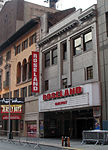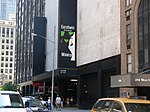August Wilson Theatre

The August Wilson Theatre (formerly the Guild Theatre, ANTA Theatre, and Virginia Theatre) is a Broadway theater at 245 West 52nd Street in the Theater District of Midtown Manhattan in New York City. Opened in 1925, the theater was designed by C. Howard Crane and Kenneth Franzheim and was built for the Theatre Guild. It is named for Pulitzer Prize-winning playwright August Wilson (1945–2005). The Wilson has approximately 1,225 seats across two levels and is operated by Jujamcyn Theaters. The facade is a New York City designated landmark. The facade is designed as a variation of a 15th-century Tuscan villa, with a stage house to the west and an auditorium to the east. The facade has a stucco surface and openings with quoins, as well as a loggia. The placement of window openings reflected the theater's original interior arrangement. The front of the theater had facilities for the Theatre Guild, including classrooms, studios, a club room, a library, and a book store. The rear of the theater contains the auditorium, which was placed one story above ground to make room for a lounge below. The auditorium originally had elaborate decorations, including loggias and a frieze with depictions of scenes from the Theatre Guild's plays. The Theatre Guild announced plans for its own theater in 1923, and the Guild Theatre opened on April 13, 1925. The theater's initial productions generally lasted only for several weeks, and the Theatre Guild started leasing the venue to other producers in 1938. Radio station WOR (AM) took over the auditorium as a broadcast studio in 1943, with the Theatre Guild moving out the next year. The American National Theater and Academy (ANTA) purchased the theater in 1950 and renamed it the ANTA Playhouse. The theater reopened as the ANTA Theatre in 1954 after a renovation that eliminated most of the interior detail. Jujamcyn purchased the ANTA Theatre in 1981 and renamed it for Virginia McKnight Binger, a co-owner. The Virginia was renovated again in the 1990s, and it was renamed for Wilson in 2005. Under Jujamcyn ownership, the theater has hosted long runs of productions including City of Angels, Smokey Joe's Cafe, and Jersey Boys.
Excerpt from the Wikipedia article August Wilson Theatre (License: CC BY-SA 3.0, Authors, Images).August Wilson Theatre
West 52nd Street, New York Manhattan
Geographical coordinates (GPS) Address Website External links Nearby Places Show on map
Geographical coordinates (GPS)
| Latitude | Longitude |
|---|---|
| N 40.763333333333 ° | E -73.984166666667 ° |
Address
August Wilson Theatre
West 52nd Street 245
10019 New York, Manhattan
New York, United States
Open on Google Maps








